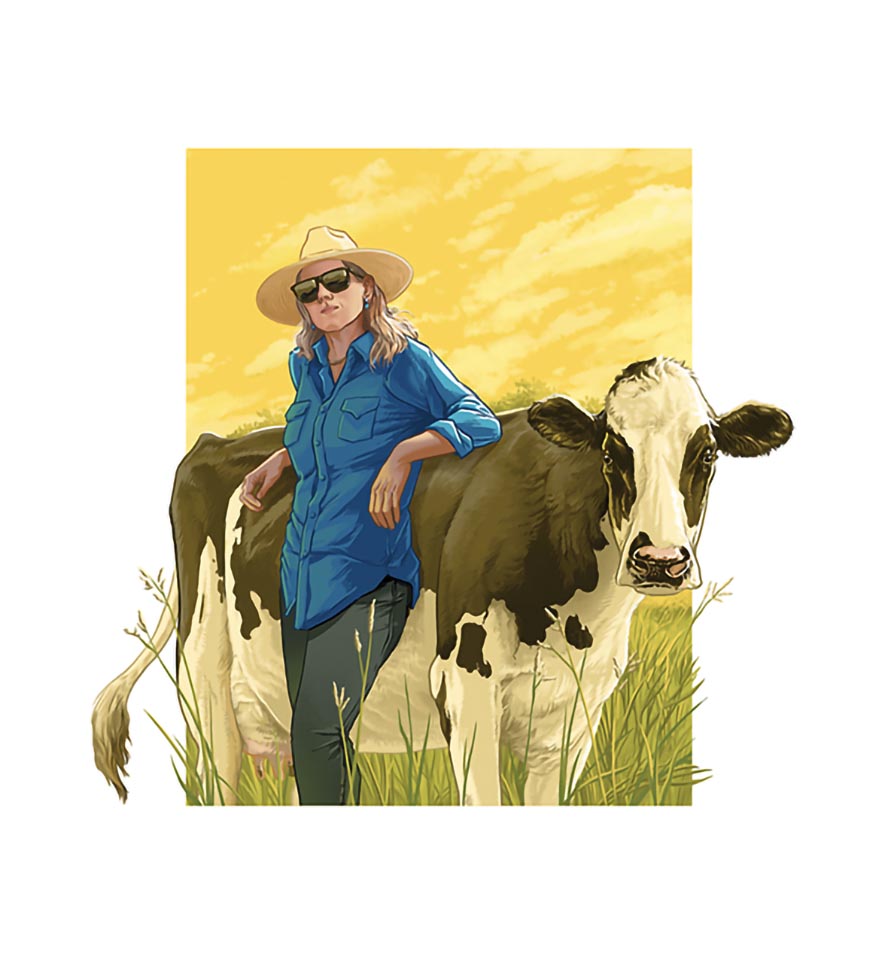Ann Radil ’99 is decarbonizing American agriculture one glass of milk at a time.

There are few topics that get Ann Radil ’99 fired up as much as decarbonizing agriculture. As the head of carbon reduction at Neutral, the start-up behind the world’s first carbon-neutral milk, Radil spends a lot of her time thinking about ways to reduce the climate impact of dairy farming. And at the end of the day, this requires Radil and her team to carefully analyze what goes into a cow — and what comes out.
“Cows contribute around 10% of all global greenhouse gas emissions, which is largely a by-product of their digestion,” Radil says. “I get super nerdy on stuff like manure management because if we can decarbonize cows, that will have a bigger climate impact than decarbonizing cement.”
In 2020 the U.S. dairy industry committed to achieving carbon neutrality by 2050, an ambitious goal that will require solving some vexing challenges. Most of the dairy industry’s greenhouse gas emissions come in the form of methane produced when cows fart and burp, but changing the diet of America’s dairy cows will only solve part of the problem. Nearly a quarter of the dairy industry’s greenhouse gas emissions result from carbon- intensive agricultural practices used to grow feed crops, with the remainder attributable to the methane released by giant ponds of manure slurry found on most dairy farms.
“Methane is active in the atmosphere for about 12 years before it tapers off, but during that 12 years, it traps 85 times more heat than carbon dioxide,” Radil says. “Methane mitigation is the closest thing we have to a silver bullet for climate change because it can give us more time to build solutions for more difficult to decarbonize industries like energy and transportation.”
America’s dairy farmers know they have a greenhouse gas problem. But tackling this issue requires them to make significant investments in changing the way their farms are run, from the types of feed crops they grow to the way they manage manure. Around half of all of America’s dairy farms are small- or medium-sized operations (managing fewer than 500 cows), and most of them simply can’t afford to implement holistic emission reduction programs on their farms. That’s where Radil and her colleagues at Neutral believe they can make a big difference.
Radil joined Neutral as its third employee in 2020 after nearly two decades of helping some of the world’s largest organizations in the world, including Coca-Cola and Nike, implement their first climate and sustainability programs. As the daughter of a farmer and a rancher whose agricultural lineage goes back generations, Radil’s decision to join Neutral was, in many ways, a return to her roots. For the past three years, she’s been leading a small team at Neutral that works directly with dairy farmers to implement a broad range of emission reduction solutions. Radil and her team advise farmers on how to decarbonize feed production by strategically planting trees, they make direct investments into dairy farms so farmers can build infrastructure for reducing the amount of manure that runs off into slurry ponds, and they’ve even launched a study to investigate how incorporating red seaweed into a cow’s diet can dramatically reduce the amount of methane produced by its digestive system.
From Radil’s perspective, decarbonizing the dairy industry requires holistic solutions that are developed in partnership with America’s dairy farmers. It will be a long and uphill battle, but for now, at least, Neutral’s approach seems to be working. In 2021 the company announced it was rolling out the carbon-neutral milk produced at its partner dairy farms in hundreds of Whole Foods locations and other grocery stores across the U.S. But this, says Radil, is just the beginning. The company has ambitions to decarbonize beef and other sectors of the food supply chain in a bid to make American agriculture not just carbon neutral, but carbon negative.
“Agriculture is the only sector that is both a heavy emitter, but also has the opportunity to be managed as a net emissions sink,” says Radil, referring to the potential for farms to absorb more greenhouse gasses than they produce. “We really hope that Neutral provides a demand signal that encourages producers to adopt sustainable practices. I know the farmers are smart, capable, and willing to do the hard work if we can give them the resources and show [them] that there’s a viable business here.”
